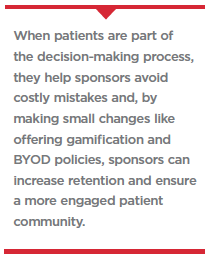How to plan for a successful patient-centric virtual trial
 Virtual and hybrid clinical trials, which require few or no visits to a trial site, have arrived as part of the new frontier of innovative, patient-centric research models. Through telemedicine, online patient portals, and connected devices, sponsors bring the trial directly to the patient so it’s easier for them to engage from beginning to end. In turn, sponsors can benefit from greater efficiencies, such as reduced costs and shorter timelines, as well as a broader geographic reach to recruit the right patients — even when competition for trial participants is fierce.
Virtual and hybrid clinical trials, which require few or no visits to a trial site, have arrived as part of the new frontier of innovative, patient-centric research models. Through telemedicine, online patient portals, and connected devices, sponsors bring the trial directly to the patient so it’s easier for them to engage from beginning to end. In turn, sponsors can benefit from greater efficiencies, such as reduced costs and shorter timelines, as well as a broader geographic reach to recruit the right patients — even when competition for trial participants is fierce.
While virtual and hybrid models offer an approach to clinical trial participation that causes less disruption to patients’ lives, it’s important to note that simply choosing a virtual trial model doesn’t guarantee a positive patient experience.
To realize the breadth of benefits virtual and hybrid models offer, trial sponsors must begin planning their virtual trials early and involve patients, their caregivers, and other key stakeholders, such as principal investigators, in the planning process.
Treat Patients as Valued Research Partners
Often clinical research is focused on the science and the science alone. As such, our industry often neglects to take the patient’s perspective into account during this critical phase of drug development.
For example, during the planning and delivery of a clinical trial, the patient’s voice is usually delivered second-hand through their physician, who interprets their needs for research. Unfortunately, this filtered communication prevents patients from actively joining the conversation early in the trial process and can result in well-meaning choices that don’t meet their needs. Involving patients directly — and early — can offer critical insights about their lives, from the way they experience a disease to their daily healthcare routines and support systems, and their tech preferences. These insights can inform and shape a trial model that truly meets their needs.
This type of approach is referred to as “design thinking," where project teams engage consumers at every stage of a project to get their feedback and adapt the design to better meet their needs and desired outcomes. Engaging consumers directly has helped some of the most innovative companies in the world generate disruptive products that transform industries, and it can give pharma companies an edge in attracting and retaining patients for next-generation trials.
What We Assumed Vs. What They Said
To design a virtual trial that is patient-centric, sponsors can conduct focus groups, face-to-face interviews, and online surveys to engage patients and caregivers before any decisions are set in stone. The goal of this outreach is not to convince patients they should participate in virtual trials. Rather, it is an opportunity for sponsors to listen and understand what it’s like to live as a patient with their disease and what patients feel sponsors could do to make participating in a trial more appealing or convenient.
When sponsors take the time to listen directly to patients rather than dictate based on filtered feedback, they can learn first-hand which outcomes are important to patients, what technology their target population would feel most comfortable using, and what additional support or training they need to participate in a trial from home. This early feedback can provide a blueprint for the trial that ensures sponsors make the right choices the first time around, which will help them avoid expensive protocol amendments and investments in technology that no one will use.
As an example, IQVIA recently worked with a sponsor developing a treatment for depression among patients with multiple sclerosis, an often disabling disease of the central nervous system. The sponsor was evaluating patients’ potential engagement in a fully virtual model, in which patients would participate remotely using data-gathering devices and telemedicine platforms and receive visiting care professionals.
The sponsor assumed patients would prefer to use a custom-designed tablet to record data about their treatment experience, side effects, and general feelings and function. Through focus group conversations and observations of their interaction with the tablet, we discovered these assumptions were incorrect.
Because of their condition, which can impair mobility in varying ways, many patients were unable to activate buttons on the touchscreen, making it difficult and frustrating to record data.
These insights led the sponsor to redesign the tablet to be more touch sensitive, and to offer a “bring your own device" — or BYOD — option allowing patients to use their own tablets or phones, which they had already configured to their needs. By taking the time to talk to patients, the sponsor was able to cut the cost of new technology investments while creating a more adaptable patient environment likely to increase engagement.
In another study, a sponsor developing a treatment for children with autism decided early on that it did not want to employ gamification elements, including leaderboards and rewards for completing tasks. The company assumed the tactic was overhyped and that parents and children would reject the technology or consider it inappropriate given the gravity of a trial.
However, in focus groups with parents, the first thing they asked for was a game-style approach to engage their children in the virtual research environment. They said it was important to give their kids recognition for achievement and felt leaderboards, badges, and other digital recognition would be an impactful way to engage them in the process. Again, assumptions made in the boardroom were proven inaccurate by simply talking to the target population.
Capturing the Patient Voice
This design-thinking-inspired approach has become an integral part of the trial planning process for IQVIA Virtual Trials. We now work with sponsors to actively engage the patient community and to create spaces where patients feel inspired to share their stories and offer their feedback.
These focus groups and surveys allow us to continually explore patients’ perceptions of and  willingness to participate in virtual trials, their preferred trial procedures related to the use of mobile technologies, and the preferred attributes of virtual health technologies.
willingness to participate in virtual trials, their preferred trial procedures related to the use of mobile technologies, and the preferred attributes of virtual health technologies.
In a recent survey, IQVIA learned that two out of three patients favor a clinical trial model that incorporates virtual elements, compared with the traditional clinical trial model that relies solely on standard in-clinic assessments. Patients said mobile clinical trials offered greater convenience, as did the reduction of in-person clinic visits, and patients noted the greater accuracy in data collection. Many patients also said they appreciated the convenience of accessing trial information at any time.
“It’s an advantage to have your information at your fingertips, as opposed to having to wait to go into a doctor’s appointment," one focus group participant said. “There is a definite advantage. Everything’s right there."
This feedback is critical to building better virtual and hybrid clinical trials.
Putting Patient-Centricity Into Practice
We’ve identified several strategies that cultivate meaningful dialogue and help foster better connections between sponsors and the patient community:
Talk to more diverse focus groups. If you rely on feedback from the same core group of patients or advocacy groups, you can introduce bias to your design decisions. These stakeholders tend to be more educated and more enthusiastic about trial participation. Including research-naïve patients in your early research will give you a more authentic perspective and make it easier to create a trial that will appeal to a more diverse group.
Include caregivers in the conversation. Even if your patient population is made up of cognitively functional and able-bodied adults, including the people who support them will help you glean hidden insights and win their buy-in for trial participation.
Listen rather than market. Focus groups are not an opportunity for sponsors to pitch a trial or product. In these forums, the patients are the subject-matter experts, so it is important to give them the space to tell their stories, share their frustrations, and offer their insights into what will make trial participation more appealing. With the right encouragement, they will tell you what you need know to create a better trial experience. Then, follow up with an online digital survey to gain more information, a cost-effective way to validate information and insights from the focus group.
Watch and learn. As you plan a trial and select virtual elements, give end users a chance to test the technology. Can they navigate the user interface? Do they understand how to recharge the device? Are they comfortable launching a telemedicine meeting and engaging virtually with an investigator? Observing how they use the technology will show you what works, where they need training, and what needs to be tweaked to improve the user experience.
Give patients a choice. Virtual trials give patients the chance to participate in research from the comfort of their own homes. But it may not be right for everyone. Opting for a hybrid trial that blends virtual and actual site visits or a side-by-side model with a virtual arm and a traditional site-based arm gives patients more choice while allowing sponsors to compare results and mitigate recruiting challenges.
By deploying these strategies, sponsors can make the most of the virtual trial experience for patients and deliver better outcomes. When patients are part of the decision-making process, they help sponsors avoid costly mistakes and, by making small changes like offering gamification and BYOD policies, sponsors can increase retention and ensure a more engaged patient community.(PV)
IQVIA Virtual Trials bring studies directly to patients at home. These flexible models can be applied across therapeutic areas and delivered as fully virtual or hybrid studies — large or small, local or global.
For more information, visit iqvia.com/virtualtrials.

















